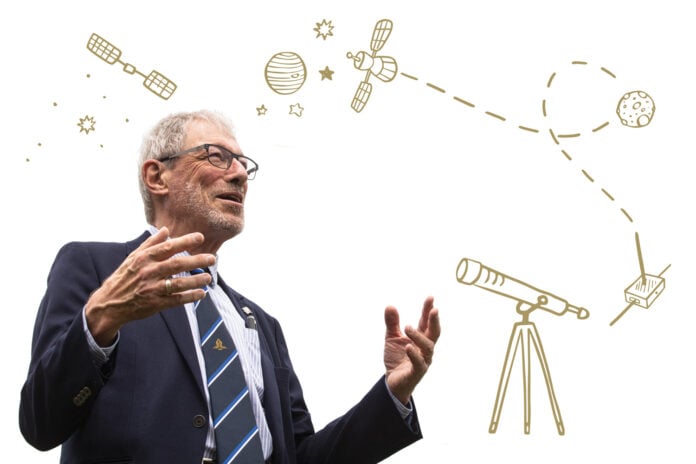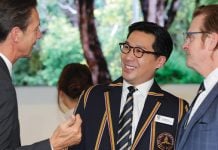Experimentation, curiosity and a healthy disregard for naysayers were key themes when Mr Richard Tonkin (OM 1961) spoke to Melbourne Grammar students about the unlikely team that built Australia’s first satellite.
While parts of Australia’s space race story have been told, few would know that our first satellite was built by an enthusiastic team of students from the University of Melbourne who sourced many of its parts through donations from local businesses.
“There were about a dozen of us in our late teens and early twenties,” Mr Tonkin told students at his February presentation. “We thought, ‘Well, why not?’ As you’ll find out, when you’re that age, there’s nothing you can’t do.”
Mr Tonkin, a former Perry House boarder and now a family lawyer with a career spanning 40 years, was the only member of the team without a background in science or maths. What he offered was a passion for space exploration first sparked during his time as a Melbourne Grammar student.
“My life changed dramatically in 1957 when the Russians launched the first satellite, Sputnik,” he told the students. “On the night of 5 October 1957, our Housemaster took us up to the top of the hill where the Shrine of Remembrance is located and told us to look up at the sky where we’d see a faint light passing. Sure enough, there it was. As an impressionable 14-year-old, I became fascinated with space from that moment. I followed all the launches and my parents subscribed to a space magazine for me—I was hooked.”
Mr Tonkin’s presentation included photos of the actual components used to create the satellite, dubbed Australis Oscar 5, along with hand-drawn diagrams used in its planning. He also shared a photo of the team standing on a University of Melbourne rooftop in 1967, preparing to launch a weather balloon.
“Air traffic control was rather more relaxed back then than it is today,” Mr Tonkin explained. “For one of our launches, they told us to wait until after we saw the 747 from San Francisco come over the horizon. We’d attached notes to the balloons that said: ‘This is not a UFO. Please ring this number and we will come and retrieve it.’ We had quite a few farmers ring us, and we also lost quite a few balloons. That was part of the deal.”
Once the team’s satellite was built and tested—using facilities including an oven in the student quarters—next came the question of transporting it to the US where it could be launched by NASA. “We were impoverished students, so we asked the then University of Melbourne Chancellor, Sir Robert Menzies, if he could fund a couple of tickets to America,” Mr Tonkin said. “He had two return tickets for us the next day. Sir Robert became our hero after that.” The satellite was delivered to NASA in a hand-painted box that read: “God Save the Queen”.
After the team returned to Australia, they spent a nervous period waiting for news. Meanwhile another satellite, created by Australia’s Weapons Research Establishment (now the Defence Science and Technology Group), was launched, making Australis Oscar 5 the first Australian satellite built, but the second launched. “It went into orbit on 23 February 1970 and lasted about six weeks until the battery was exhausted although, because of the height of its orbit, the satellite is expected to stay in space for another 100,000 years,” Mr Tonkin said.
Mr Tonkin left students with a strong message to believe in their ideas, even when faced with opposition. “People told us: ‘You’re mad. It can’t be done. Get on with your studies. Don’t be silly.’ But the moral of the story is, if people tell you that you can’t achieve something, just ignore them. There’s nothing you can’t do.”


